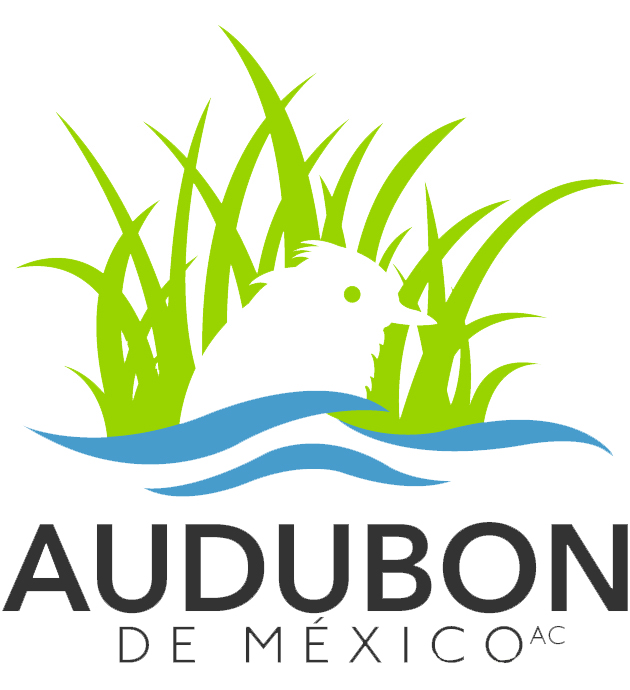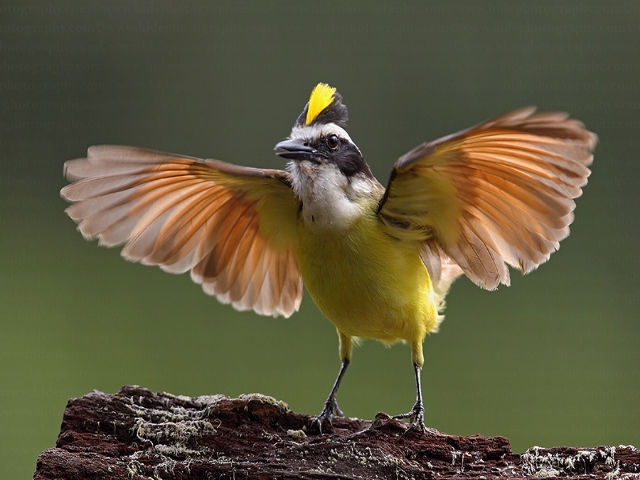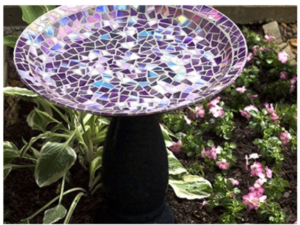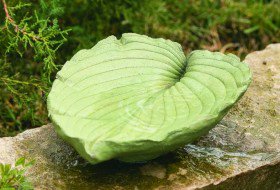Invite Birds into Your Garden
Feeding Birds
According to those who study birds, feeding birds is probably the most common way in which people interact with wild animals today. Millions of people around the world feed birds, but is it good for birds? Turns out, that the research indicates that birds do not need feeder food, while poorly maintained feeders can expose them to serious disease and infections. Feeding birds can also encourage populations of birds that tend to proliferate in urban areas, such as pigeons, doves, sparrows and grackles and potentially push out the native and migratory birds that we are really trying to help.
But these scientists and bird conservation organizations also say that feeding birds is not necessarily bad for birds either, and may serve to supplement their needs during the winter or nesting season
So what to do? If you want to help birds and attract birds to your garden, it’s best to make sure they have wild food, water and places to roost, find shelter and nest. Providing supplemental food is okay too, so long as we follow the advice in the adjacent tabs.
Articles of Interest:
This is a wonderful article about urban bird feeding that provides food for thought and reflections on the human/wildlife connection
The good and the bad news about feeding birds is revealed in this article.
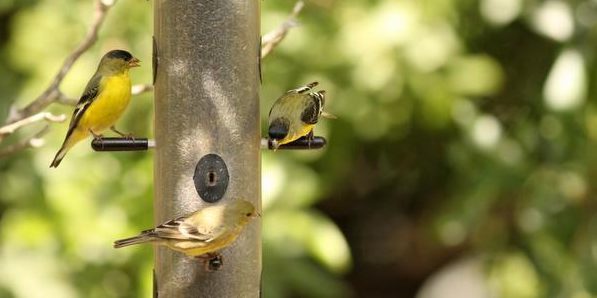
1. Locate bird feeders at different levels to attract the greatest variety of species and avoid overcrowding
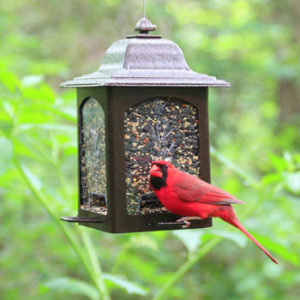
To avoid crowding and to attract the greatest variety of species, you can create a bird café by providing feeders for ground-feeding birds (given you are not worried about predators) placed on the ground or just a few feet off the ground. For birds that usually eat from shrubs, waist height or at eye level is best. Place hummingbird and suet feeders about 5’ – 6’ off the ground. Make sure, however, that the placement of feeders is convenient for you, so that filling and cleaning the feeders does not become a burden. Keep bird feeders and bird baths at least five feet from any shrubbery that can conceal a stalking predator.
2. Offer a variety of seeds in separate feeders
A diverse mix of seeds will attract the greatest variety of birds. To avoid waste, offer different seeds in different feeders. Black oil sunflower seed appeals to the greatest number of birds. Offer sunflower seeds, nyjer (thistle) seeds, and peanuts in separate feeders. When using blends, choose mixtures containing sunflower seeds, millet, and cracked corn—these are very popular with the birds.
7. Store seed in secure metal containers in a cool, dry location
9. Locate feeders to reduce window collisions
10. Keep cats away from the birds
Cats, whether they are our pets, feral or the neighbor’s cat, kill millions of birds annually. It’s best to keep our cats indoors or while outdoors in a “catio,” but that’s not always possible, especially when the cat is not yours. If you have a problem with feral or stray cats in your neighborhood, consider trapping them and taking to the S.P.A. or Amigos de Animales for spaying or neutering. They can then be returned outdoors or put up for adoption, which in the long-term will help birds and prevent a population boom in your neighborhood. As food for thought, according to the American Society for the Prevention of Cruelty to Animals (ASPCA) 74 kittens can be born each year because of one unspayed female.
11. Clean feeders and rake up spilled grain and hulls
What to plant in your garden:
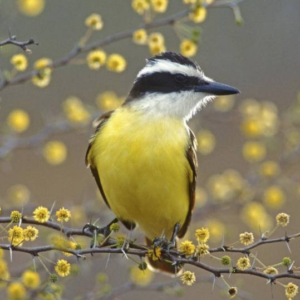 Birds have developed over millions of years by adapting to their environments and the foods that sustained them. The best we can do for birds is to ensure that they have the foods that they find in the wild, which means, planting flowers, shrubs and trees that provide seeds and berries. We also need to avoid using pesticides and herbicides.
Birds have developed over millions of years by adapting to their environments and the foods that sustained them. The best we can do for birds is to ensure that they have the foods that they find in the wild, which means, planting flowers, shrubs and trees that provide seeds and berries. We also need to avoid using pesticides and herbicides.
We are working on a list of locally available plants, both native and those adapted to our environment for feeding birds.
When you sign up for our newsletter we’ll send you this information when we have completed this work or check this page again in the near future.
Suet:
Providing suet during winter months, can attract a great variety of birds to your garden and provides them with supplemental nourishment.
Some of the birds attracted to suet are woodpeckers, wrens, warblers, thrashers, robins, orioles, cardinals, northern mockingbirds and grosbeaks.
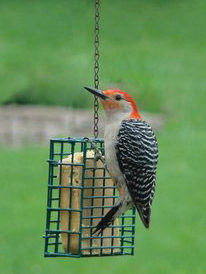 Suet cake can be hung in a mesh bag, within a wire cage, or on a platform feeder. You can also smear into the bark of a tree. Peanut butter (made without sugar) is a good substitute for suet in the summer. Mix one part peanut butter with five parts corn meal.
Suet cake can be hung in a mesh bag, within a wire cage, or on a platform feeder. You can also smear into the bark of a tree. Peanut butter (made without sugar) is a good substitute for suet in the summer. Mix one part peanut butter with five parts corn meal.
Hang the bag or cage 5-6’ above the ground, close to a tree, if possible (but far enough away that predators can’t leap out to catch the birds).
Fruit:
Many birds enjoy fruit, including orioles. Place quartered or chunks of oranges, apples, melons and grapes on a platform feeders or you can tie half an orange or apple to a tree branch. Apples, pears and plums can be halved and left on the ground for robins and other ground feeding birds.
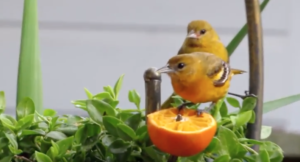
Check out this interesting orange feeder.
Refer to our bird list to find out more about our local birds. In general, notice the shape of a bird’s beak to identify what it likely eats. Conical or triangular bills generally prefer seeds, while pointed beaked birds are insect eaters.
Providing a dependable supply of fresh, clean water can attract a variety of birds to your garden and it’s something important we can do to help birds too. Like all animals, birds need water to survive, and although they can obtain moisture from their food, most birds drink water every day.
Birds also use water for bathing to free themselves from parasites and to keep their feathers in top shape. A simple shallow birdbath should be all you need to call in the birds.
If your goal is to attract hummingbirds, most birdbaths are too deep for these tiny creatures. Better for them, is a mister, a spray system for a birdbath or a fountain that makes a splash.
Water for Birds
Drinking bowl
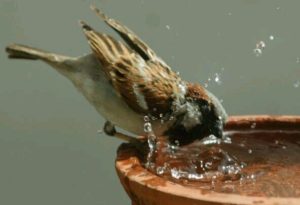 If you feel certain that birds will be safe from neighborhood cats, you can set out a small shallow pan or dish, filled with an inch or two of water, and place under a shrub or play around with other locations to see what happens. Make sure that the container has a lip for them to stand on or create a depression in the ground for the bowl to fit into.
If you feel certain that birds will be safe from neighborhood cats, you can set out a small shallow pan or dish, filled with an inch or two of water, and place under a shrub or play around with other locations to see what happens. Make sure that the container has a lip for them to stand on or create a depression in the ground for the bowl to fit into.
Birdbaths
A bird bath is the perfect water solution for both drinking and bathing that can draw new birds to your garden and make your usual visitors very happy.
A good birdbath will mimic a shallow puddle, which are birdbaths that nature provides. Look for one with a bowl that can be easily cleaned, and has a gentle slope so birds can wade into the water.
Make your own from a decorative ceramic pot saucer or a terracotta saucer that you water proof by painting. You can keep it simple or go wild with decorating your saucer but keep in mind the following (this goes for any birdbath):
- Avoid slippery surfaces. If you think it might be slippery, add gravel or rocks for perches.
- Select surfaces that can be easily cleaned. You’ll want to change the water every couple of days to avoid algae build-up. Use any leftover water to make a neighboring plant happy.
- Place on a pedestal so that kitties cannot reach. According to some sources, birds prefer water basins that are on the ground, but for safety, hanging a birdbath from a tree limb (making sure it is away from the trunk of the tree) or a patio overhang or placing it on a 3-4” pedestal will help to insure the safety of the birds you are inviting in.
- If you want to attract hummingbirds and smaller birds to a birdbath, add a gravel island or two to the container. A rock island that is above the water level is a good idea for all birdbaths when the weather is cold.
There are hundreds of ideas for DIY birdbaths, here’s a couple to get your creative juices flowing:
Fountains
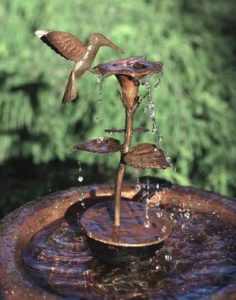 Fountains are the ultimate birdbath, especially if they splash or have water running over the lip or edge into a lower bowl. This link will take you to some attractive and functional fountains for birds. Just keep in mind that we need to be water conscious in San Miguel, so if you have a choice, please choose an alternative to a fountain or a small fountain that reduces the amount of water used. Another thing to keep in mind is that birds need shallow sources of water, deep fountains will not work.
Fountains are the ultimate birdbath, especially if they splash or have water running over the lip or edge into a lower bowl. This link will take you to some attractive and functional fountains for birds. Just keep in mind that we need to be water conscious in San Miguel, so if you have a choice, please choose an alternative to a fountain or a small fountain that reduces the amount of water used. Another thing to keep in mind is that birds need shallow sources of water, deep fountains will not work.
Make your own mud puddle
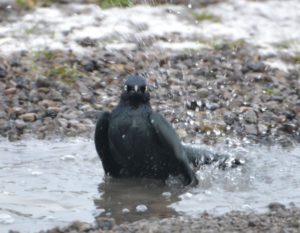 Dig a shallow hole in the ground, making sure that the water depth will be no greater than a couple of inches. Line it with plastic or cement to make it watertight. Add rocks and plants around the edges, but leave some edges free for the birds to stand while drinking.
Dig a shallow hole in the ground, making sure that the water depth will be no greater than a couple of inches. Line it with plastic or cement to make it watertight. Add rocks and plants around the edges, but leave some edges free for the birds to stand while drinking.
Protecting Nesting Birds
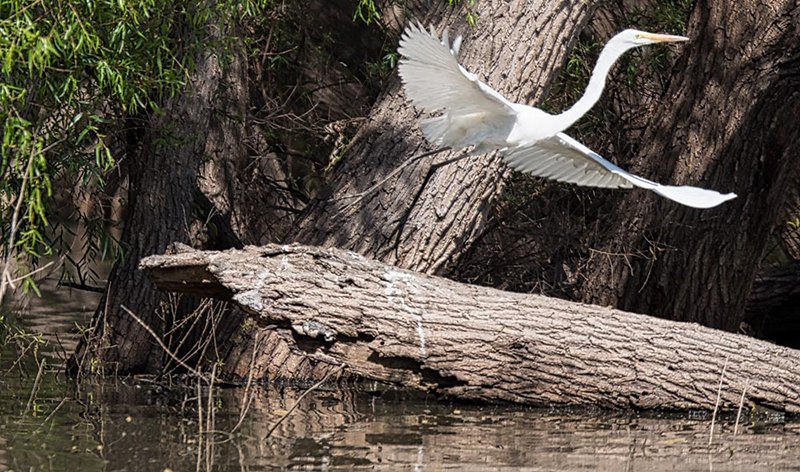
Refrain from pruning your trees or hedges during the nesting season, because these are likely spots where birds will be nesting. For most species, the nesting season generally takes place between February and June, but a few species may be tending a second brood or raising their babies in the nest until late summer.
Consider placing a bird house in your garden. This chart shows the size of birdhouse for particular bird species we have in San Miguel.
Egrets: Egrets nest in colonies, and we realize that they can be a nuisance. Please be tolerant because they need these places to bear and raise their young. To discourage them from nesting in your garden or yard, have trees pruned between November and March.
Subscribe to our newsletter
Our monthly newsletter will keep you up to date on our scheduled events, our work, and features monthly nature-related articles.
